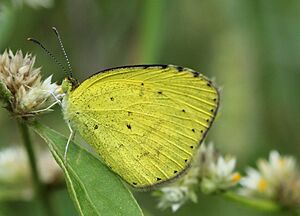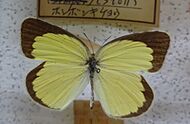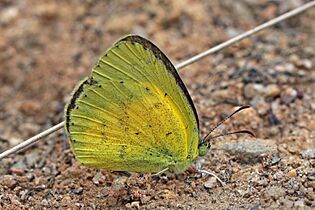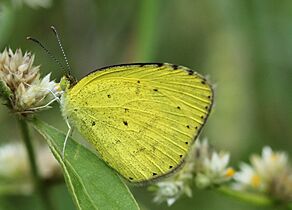Small grass yellow facts for kids
Quick facts for kids Small grass yellow |
|
|---|---|
 |
|
 |
|
| Imago (above) and final instars (below) | |
| Conservation status | |
| Scientific classification | |
| Genus: |
Eurema
|
| Species: |
brigitta
|
| Synonyms | |
|
|
Eurema brigitta, the small grass yellow or broad-bordered grass yellow, is a small butterfly of the family Pieridae, that is, the yellows and whites. It is found in India, other parts of Asia, Australia and Africa.
Contents
Description
Wet-season form: Male. Upper-side somewhat paler yellow. Fore-wing with the outer marginal black band; the apical edge of costa and the cilia rosy-red. Hind-wing with the black outer band somewhat narrower, macular, the decreasing portions each with a more prolonged inner-tooth, and the yellow ground-colour between each extending to the outer edge. Underside pale yellow, the fore-wing also having a very slightly defined sub-apical inwardly-oblique squamous streak. Fore-wing with the entire costal edge and outer marginal cilia, and also the outer marginal cilia of the hind-wing, rosy-red. Female. Upper-side. Apical edge between the subcostals of fore-wing, and cilia of both wings paler rosy-red. Underside with the markings on hind-wing slightly visible. Fore-wing above with the black outer band broken beneath the lower median veinlet. Hind-wing with the outer band similar to male, its portions slightly broader. Underside similar to male, the markings being slightly more defined.
Intermediate form: Male. Upper-side. Fore-wing with the outer band slightly narrower than in wet form; cilia paler red. Hind-wing with the marginal macular band narrower, and composed of smaller portions. Underside similar to wet form. Female. Upperside. Fore-wing with the outer band less broken at its posterior end than in wet form. Hind-wing with the marginal macular band less distinct and narrower. Underside similar to the male.
Dry-season form: Both sexes much smaller than in intermediate form. Cilia paler. Male. Fore-wing above with the inner-edge of the marginal band less sinuated than in intermediate form, its posterior end indistinctly broken. Hind-wing with the lower portions of the macular band somewhat larger and less dentate. Underside. Both wings with less defined markings than in intermediate form. Female. Upper-side. Fore-wing with the band slightly broken at posterior end. Hind-wing with the lower portions of band somewhat wider. Underside with the markings indistinct.—Charles Swinhoe, Lepidoptera Indica. Vol. VII
The wingspan is 30–35 mm. Adults are on the wing year-round.
Food plants
The larvae feed on Hypericum aethiopicum and Chamaecrista mimosoides.
Subspecies
- E. b. brigitta – tropical Africa
- E. b. pulchella (Boisduval, 1833) – Madagascar, Mauritius, Comoro Islands, Aldabra Islands
- E. b. drona (Horsfield, [1829]) – Sumatra, Java to Lombok
- E. b. senna (C.&R.Felder, [1865]) – Peninsular Malaya, Singapore, Indochina
- E. b. fruhstorferi (Moore, 1906) – eastern Indo-China
- E. b. ina Eliot, 1956 – southern Sulawesi
- E. b. hainana (Moore, 1878) – Hainan
- E. b. rubella (Wallace, 1867) – Sri Lanka, India, Burma to southern China, Nicobars
- E. b. formosana Matsumura, 1919 – Taiwan
- E. b. yunnana (Mell)
- E. b. australis (Wallace, 1867) – Australia, New Guinea, Papua New Guinea
Gallery
-
E. b. brigitta, KwaZulu-Natal, South Africa
-
E. b. pulchella, Madagascar
See also
- List of butterflies of India
- List of butterflies of India (Pieridae)







